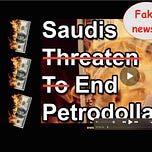On Eid al-Adha, the Feast of the Sacrifice—the Muslim world’s biggest holiday, with more than 1.5 million pilgrims congregating in Mecca—the Saudi authorities decided to make it an even bigger holiday…and sacrificed the petrodollar. Worldwide feasting and celebration erupted. Ding-dong, the witch is dead! The US empire is no more! Uncle Schlemiel has finally bit the dust!
The implosion of Israel’s American sponsor ended the genocide in Occupied Palestine. Eid al-Adha, which commemorates the end of human sacrifice in general and the ritual slaughter of children in particular, was an auspicious moment to terminate the Zionists’ sacrifice of 15,000+ children in Gaza. Saudi leader Mohammed Bin Salman, previously best known for carving up political enemies with bone saws, has rehabilitated his image and will henceforth be remembered alongside Salahuddin Ayyubi as a liberator, not a tyrant.
The Saudis’ sacrifice of the petrodollar also ended the war in Ukraine. The collapsing dollar, no longer supported by oil, lost its power to pay for US occupation of Europe and the empire’s war on Russia. Putin’s peace agreement, freezing the conflict at its current boundaries, was quickly implemented. US plans to turn Taiwan into Ukraine 2.0, leading to World War III against China, were abruptly cancelled.
It’s a nice story. Billions wish it were true. But initial reports of the petrodollar’s demise, like those of Mark Twain’s in 1897, appear to have been greatly exaggerated.
I got the (fake) news from Australian conspiracy researcher Peter Myers, who forwarded several stories including “Saudi Arabia has dumped the PetroDollar; the deal expired on June 9, 2024.” The claim seems to have originated in India Today, the most widely circulated magazine in India, and the Deccan Herald, another venerable Indian publication.
When two of the biggest publications in the world’s most populous nation report that a historic event has occurred, we might be excused for taking them seriously. But the Indian reports of the alleged expiration of the US-Saudi petrodollar agreement raised more questions than answers.
The Deccan Herald reported the expiration of an alleged 50-year-old agreement:
The US-Saudi Petrodollar deal established on June 8, 1974 was an agreement through which Saudi Arabia agreed to trade crude oil in US dollars in exchange for military equipment and assistance from the US.
India Today, for its part, said the agreement that had just expired was 80 years old:
The US-Saudi Arabia petrodollar deal, a pivotal arrangement in global finance, has ended after 80 years. This landmark deal, initiated on June 8, 1974, facilitated the exchange of US dollars for crude oil exports, bolstering the dollar's dominance.
The Deccan Herald writer was apparently better at math, since June 1974 was 50 years ago, not 80 years ago. So where did India Today get its 80-year time frame? Presumably because the US-Saudi “special relationship” began roughly 80 years ago—79 and a few months, actually—when US President Franklin D. Roosevelt met Saudi King Abdul Aziz Ibn Saud aboard the USS Quincy and “forged the basis of a long relationship: America’s security guarantees for the kingdom in return for access to affordable energy supplies.”*
To further confuse matters, another reasonably prestigious publication, Islamicity.org, echoed claims that Saudi Arabia had formally repudiated the alleged petrodollar pact which, “in place for 75 years, marked the US dollar as the world's reserve currency, granting economic stability and access to rising asset prices.”
So was there ever a formal US-Saudi agreement mandating that the Saudis sell oil in US dollars? And if so, is it 80 years old, 75 years old, or 50 years old? If such an agreement existed, did the Saudis just refuse to renew it? And if there is no such agreement, and the above-cited reports are fake news, who made up the fake news, and why?
Wyatt “W-Mike” Peterson and I discussed the mystery on this week’s False Flag Weekly News. We cited debunkings of the aforementioned Indian media reports, noted the conspicuous lack of evidence for any public and explicit “petrodollar pact” between Washington and Riyahd, and entertained various possibilities including:
*There really is a secret petrodollar pact that just expired and the Indian media got wind of it.
*There is no such explicit pact, and the fake news reports were (a) clickbait, (b) a psyop, (c) a scam, or (d) an innocent mistake.
If they were a geopolitical psyop, who benefits? Will fake news reports like these contribute to eroding the world’s confidence in the dollar? Or, on the contrary, will their pre-planned debunking “inoculate” global public opinion and thereby help maintain dollar hegemony?
Or were they a scam, presumably orchestrated to cause a brief blip in gold and bitcoin? Was there any such blip? Is there any record of investors quickly buying and selling around any such blip? If so, is this another 9/11 put options case, meaning that “national security” will be invoked to prevent us from ever learning the identities of the perpetrators?
Whatever the truth may be, one thing is clear: There is a long-term trend away from the US dollar as global reserve currency. So even if the Saudis did not succeed in slaughtering the petrodollar in one fell swoop on Eid 1445 AH, the death of the hegemonic dollar, like that of Mark Twain, is inexorable, despite its having been prematurely reported.
*Coincidentally, I happen to be be in the process of brushing up on my Arabic by reading Abdelrahman Munif’s Cities of Salt, an indigenous Arabian account the Americans’ arrival in the region.













Share this post